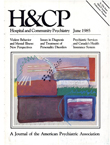Seclusion and Restraint in 1985: A Review and Update
Abstract
The 1982 Supreme Court decision in Youngberg v. Romeo gave mental health professionals fiexibility to exercise professional judgment in using seclusion to control violent patients, and also suggested that seclusion and restraint might be used when patients exhibit disruptive bebavior ior that may lead to violence. The authors reviewed 13 studies of seclusion and restraint in adult inpatient psychiatric settings to define indications for use. They found that seclusion and restraint practices varied widely depending on the population served and the philosophical onentation of the hospital staff, and were more often used to contain behavior that might lead to violence rather than to control vialent behavior itself. They conduce that there is overwhelming empirical support for using seclusion and restraint to limit the progression of disruptive behavior to actual violence, but that the decision to do so should be based on sound clinical judgment.
Access content
To read the fulltext, please use one of the options below to sign in or purchase access.- Personal login
- Institutional Login
- Sign in via OpenAthens
- Register for access
-
Please login/register if you wish to pair your device and check access availability.
Not a subscriber?
PsychiatryOnline subscription options offer access to the DSM-5 library, books, journals, CME, and patient resources. This all-in-one virtual library provides psychiatrists and mental health professionals with key resources for diagnosis, treatment, research, and professional development.
Need more help? PsychiatryOnline Customer Service may be reached by emailing [email protected] or by calling 800-368-5777 (in the U.S.) or 703-907-7322 (outside the U.S.).



